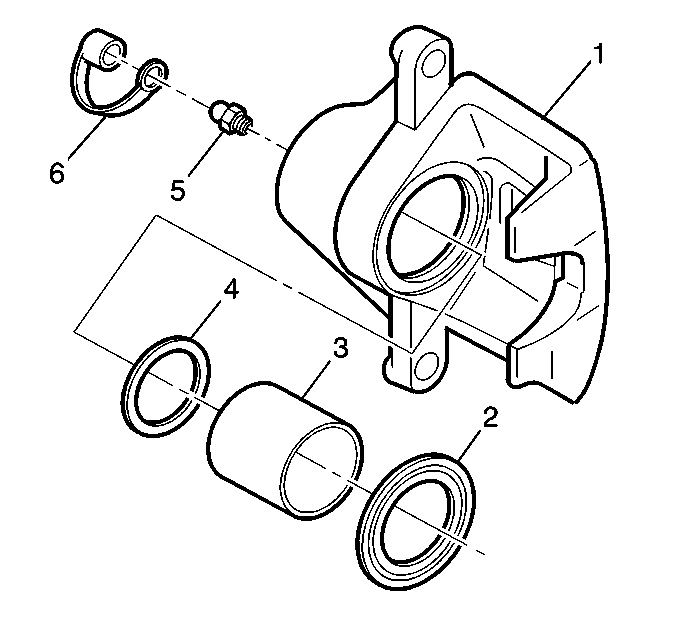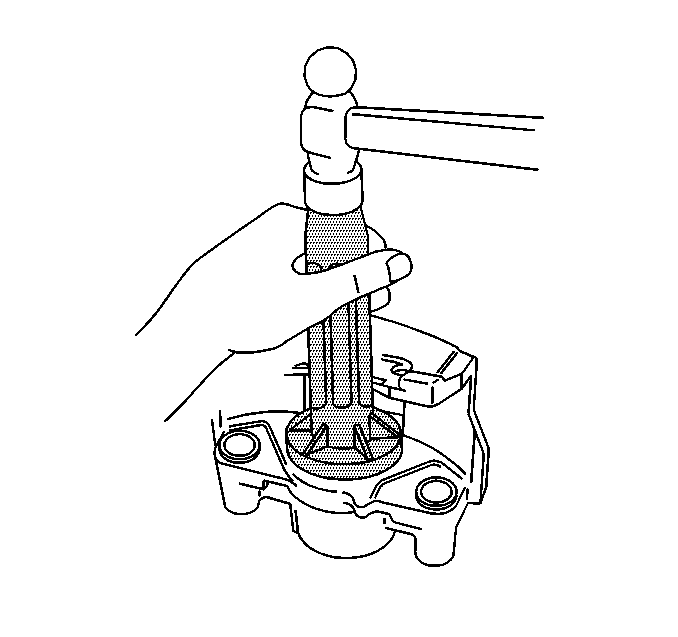Tools Required
Caliper Piston Seal Installer
- Remove the brake caliper from the vehicle. Refer to Front Brake Caliper Replacement .
- Remove the caliper piston by directing low pressure compressed air into the brake caliper through the fluid inlet hole.
- Remove the piston boot (2) from the caliper (1).
- Remove the piston seal (4) from the caliper (1).
- Remove the bleeder valve (5) and cap (6) from the caliper (1).
- Clean all of the parts. Use clean denatured alcohol.
- Dry all of the parts with low pressure non-lubricated filtered air.
- Blow out all of the passages in the caliper body and the bleeder valve.
- Inspect all of the parts as follows:
- Install the bleeder valve cap and bleeder valve into the caliper.
- Install the new piston seal. Lubricate the seal with new Delco Supreme 11® (GM P/N 12377967) or equivalent brake fluid before installing.
- Install the new piston boot over the piston.
- Using the J 35777 fully seat the boot in the caliper.
- Install the caliper onto the vehicle. Refer to Front Brake Caliper Replacement .

Caution: Do not place your fingers in front of the piston in order to catch or protect the piston while applying compressed air. This could result in serious injury.
Notice: Use clean cloths to pad interior of caliper housing during piston removal. Use just enough air to ease the pistons out of the bores. If the pistons are blown out, even with the padding provided, it may be damaged.

Important: Care must be used when removing the piston boot and seal from the caliper. Use a small plastic or wood tool for removal.
| • | Piston - Inspect for scoring, nicks, cracks, wear, or corrosion. Replace the piston if any damage is found. |
| • | Caliper Bore - Inspect for scoring, nicks, cracks, wear, or corrosion. Use crocus cloth to polish out light corrosion. Otherwise, replace the caliper. Do not hone the caliper bore. |
| • | Seal groove - Inspect for nicks or burrs in the seal groove in the caliper bore. If found, replace the caliper. |
Notice: Use the correct fastener in the correct location. Replacement fasteners must be the correct part number for that application. Fasteners requiring replacement or fasteners requiring the use of thread locking compound or sealant are identified in the service procedure. Do not use paints, lubricants, or corrosion inhibitors on fasteners or fastener joint surfaces unless specified. These coatings affect fastener torque and joint clamping force and may damage the fastener. Use the correct tightening sequence and specifications when installing fasteners in order to avoid damage to parts and systems.
Tighten
Tighten the bleeder valve to 13 N·m (115 lb in).

